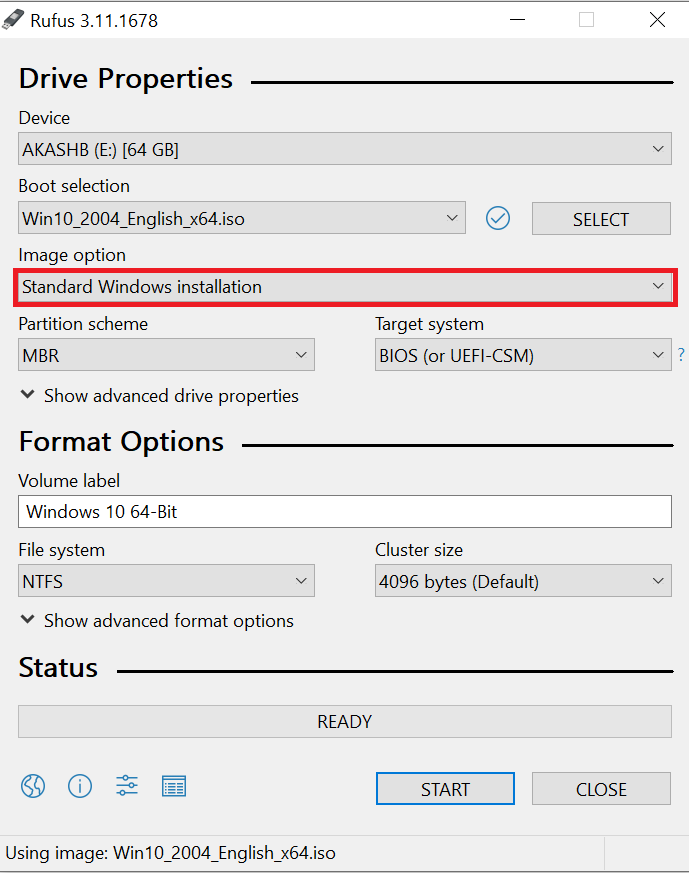
- #Windows 10 usb tool rufus download how to#
- #Windows 10 usb tool rufus download install#
- #Windows 10 usb tool rufus download drivers#
- #Windows 10 usb tool rufus download software#
#Windows 10 usb tool rufus download install#
Or you can use Rufus, a third-party tool that makes it easy to create a flash drive to install the OS on a compatible or incompatible devices. You can use the official Media Creation Tool to download the files onto a removable storage. On Windows 11, you have at least two tools to download the installation files onto a USB flash drive and make it bootable. However, since you cannot officially purchase physical installation media, you need to create one yourself. Select NTFS if the program errors as above.Although you can install Windows 11 in multiple ways, if you plan to start from scratch, you would usually use a bootable USB flash drive to proceed with the setup. Selecting MBR and FAT32 will support both UEFI and Legacy. In general, choose GPT if you only need UEFI support. This ISO image contains a file larger than 4GB, which is more than the maximum size allowed for a FAT or FAT32 file system. If you get this error message, it means that the ISO file contains a file larger than 4GB. In this case, choose NTFS instead of FAT32, Rufus will create a second FAT32 partition to support UEFI boot. Click the START button to start creating.File system: This option is very important, it decides bootability in UEFI or Legacy. To support Legacy, you need to select MBR instead of GPT.

Volume label: The program will extract this information from the ISO file, which you can change if you want.Target system: This option depends on the Partition scheme option, or BIOS or UEFI, or BIOS (or UEFI-CSM), or UEFI (non CMS).Or select Standard Windows Installation to create the installer to install to any other drive. Image Option: You can install Windows onto USB drive with Rufus’s Windows To Go option.Click the SELECT button and select the ISO file on your computer.Select the USB drive you want to create under Device.Īll data on this drive will be lost, including other partitions on the hard disk of this partition.Rufus also supports creating two NTFS partitions to store files larger than 4GB and FAT32 to boot UEFI. If the ISO file contains files larger than 4GB, choose NTFS.īy default, Rufus will not support booting in both UEFI and Legacy (BIOS). Rufus 3.0 has improved on the interface.Ĭhoose the right options according to your needs:
#Windows 10 usb tool rufus download software#
First, download the latest version of Rufus here and then run the software to get started.
#Windows 10 usb tool rufus download how to#
Rufus is lightweight and easy to use. Here are the detailed steps on how to use Rufus to install Windows 10 for beginners.
#Windows 10 usb tool rufus download drivers#
Supports USB 3.0 driver for Windows 7 and SATA/RAID/SCSI drivers for Windows XP.Also supports hard drive, external hard drive and SDcard.In addition, AIO Boot also supports creating Windows 10 bootable USB and a lot of other operating systems that you can use: You need to use older versions or other tools in this case. Rufus 3.0 is no longer supported on Windows XP. This tool does not support creating multiboot usb with multiple ISO files, and can not have multiple operating systems on USB unless the ISO file supports it. Rufus requires reformatting the USB drive for each use. This tool does not support hard drive (HDD) and external hard drive. If you want to create a bootable hard drive or an external hard drive, Rufus is not the choice. Only supports USB (not tested with SDcards).Rufus offers many great features but it also has limitations.


Rufus is a simple and easy to use tool, just download and run the tool to create bootable USB. You can easily use Rufus to create Windows 10 bootable USB and many other operating systems including Windows XP, Windows 7, 8, 8.1, Ubuntu and many other Linux distributions. This tool has a long history of development (from 2011), Rufus 3.4 is currently the latest version updated in 2018. Personally I like this tool because it’s lightweight, simple and easy to use. This article will guide you how to use Rufus to install Windows 10 that supports both UEFI and Legacy. Rufus is one of the best USB bootable software.


 0 kommentar(er)
0 kommentar(er)
